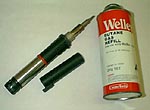Soldering Tools
The only tools that are essential to solder are a soldering iron and some solder. There are, however, lots of soldering accessories available (see soldering accessories for more information).
Different soldering jobs will need different tools, and different temperatures too. For circuit board work you will need a finer tip, a lower temperature and finer grade solder. You may also want to use a magnifying glass. Audio connectors such as XLR's will require a larger tip, higher temperature and thicker solder. Clamps and holders are also handy when soldering audio cables.
Soldering Irons
 There
are several things to consider when choosing a soldering iron.
There
are several things to consider when choosing a soldering iron.
- Wattage
- adjustable or fixed temperature
- power source (electric or gas)
- portable or bench use
I do not recommend soldering guns, as these have no temperature control and can get too hot. This can result in damage to circuit boards, melt cable insulation, and even damaged connectors.
Wattage
It is important to realise that higher wattage does not necessarily mean hotter soldering iron. Higher wattage irons just have more power available to cope with bigger joints. A low wattage iron may not keep its temperature on a big joint, as it can lose heat faster than it can reheat itself. Therefore, smaller joints such as circuit boards require a lesser wattage iron - around 15-30 watts will be fine. Audio connectors need something bigger - I recommend 40 watts at least.
Temperature
 There
are a lot of cheap, low watt irons with no temperature control available.
Most of these are fine for basic soldering, but if you are going to
be doing a lot you may want to consider a variable temperature soldering
iron. Some of these simply have a boost button on the handle, which
is useful with larger joints, others have a thermostatic control so
you can vary the heat of the tip.
There
are a lot of cheap, low watt irons with no temperature control available.
Most of these are fine for basic soldering, but if you are going to
be doing a lot you may want to consider a variable temperature soldering
iron. Some of these simply have a boost button on the handle, which
is useful with larger joints, others have a thermostatic control so
you can vary the heat of the tip.
If you have a temperature controlled iron you should start at about 315-345°C (600-650°F). You may want to increase this however - I prefer about 700-750°F. Use a temperature that will allow you to complete a joint in 1 to 3 seconds.
Power
 Most
soldering irons are mains powered - either 110/230v AC, or benchtop
soldering stations which transform down to low voltage DC. Also available
are battery and gas powered. These are great for the toolbox, but
you'll want a plug in one for your bench. Gas soldering irons lose
their heat in windy outside conditions more easily that a good high
wattage mains powered iron.
Most
soldering irons are mains powered - either 110/230v AC, or benchtop
soldering stations which transform down to low voltage DC. Also available
are battery and gas powered. These are great for the toolbox, but
you'll want a plug in one for your bench. Gas soldering irons lose
their heat in windy outside conditions more easily that a good high
wattage mains powered iron.
Portability
Most cheaper soldering irons will need to plug into the mains. This is fine a lot of the time, but if there is no mains socket around, you will need another solution. Gas and battery soldering irons are the answer here. They are totally portable and can be taken and used almost anywhere. They may not be as efficient at heating as a good high wattage iron, but they can get you out of a lot of hassle at times.
 If
you have a bench setup, you should consider using a soldering station.
These usually have a soldering iron and desoldering iron with heatproof
stands, variable heat, and a place for a cleaning pad. A good solder
station will be reliable, accurate with its temperature, and with
a range of tips handy it can perform any soldering task you attempt
with it.
If
you have a bench setup, you should consider using a soldering station.
These usually have a soldering iron and desoldering iron with heatproof
stands, variable heat, and a place for a cleaning pad. A good solder
station will be reliable, accurate with its temperature, and with
a range of tips handy it can perform any soldering task you attempt
with it.
Solder
 The
most commonly used type of solder is rosin core. The rosin is flux,
which cleans as you solder. The other type of solder is acid core
and unless you are experienced at soldering, you should stick to rosin
core solder. Acid core solder can be tricky, and better avoided for
the beginner.
The
most commonly used type of solder is rosin core. The rosin is flux,
which cleans as you solder. The other type of solder is acid core
and unless you are experienced at soldering, you should stick to rosin
core solder. Acid core solder can be tricky, and better avoided for
the beginner.
Rosin core solder comes in three main types - 50/50, 60/40 and 63/37. These numbers represent the amount of tin and lead are present in the solder,as shown below.
|
Solder Type |
% Tin |
% Lead |
Melting Temp (°F) |
|
50/50 |
50 |
50 |
425 |
|
60/40 |
60 |
40 |
371 |
|
63/37 |
63 |
37 |
361 |
Any general purpose rosin core solder will be fine.
Next Page: Soldering Accessories